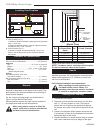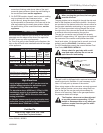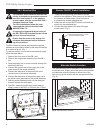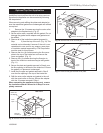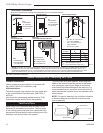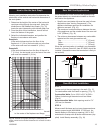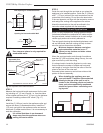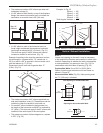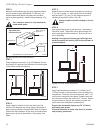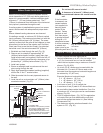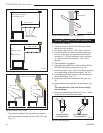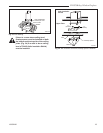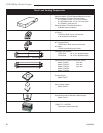
13
DVRTSB Bay Window Fireplace
10003848
The vent chart should be read in conjunction with the
following vent installation instructions to determine the
relationship of the vertical and horizontal dimensions of
the vent system.
1. Determine the height of the center of the horizontal
vent pipe exiting through the outer wall. Using this
dimension on the Sidewall Vent Graph, (Fig. 15)
locate the point intersecting with slanted graph line.
2. From the point of this intersection, draw a vertical
line to the bottom of the graph.
3. Select the indicated dimension, and position the
fireplace in accordance with same.
Example A:
If the vertical dimension from the floor of the
fireplace is 11’ (3.4 m) the horizontal run to the face
of the outer wall must not exceed 14’ (4.3 m).
Example B:
If the vertical dimension from the floor of the unit is
7’ (2.14 m), the horizontal run to the face of the outer
wall must not exceed 8¹⁄₂’ (2.6 m).
How to Use the Vent Graph
Rear Wall Vent Applications
When installed as a rear vent unit this appliance may
be vented directly to a termination located on the rear
wall behind the appliance.
• Specific rear vent starter kits must be used in these
applications (see ‘Venting Components’). The
appliance has been approved for installation flat
against a rear wall. (Fig. 16)
• The maximum horizontal distance between the rear
of the appliance and the outside face of the rear wall
is 20” (508mm). (Fig. 16)
• The minimum clearances between any combustible
material and the vent pipe sections are:
Top ..................................................... 2” (51 mm)
Sides ..................................................1” (25 mm)
Bottom ................................................1” (25 mm)
When the vent termination is installed in an accessible
location, a Screen Guard Kit, item #7V1B60, should be
installed. (Accessible means the termination is likely to
be touched)
Horizontal dimension from the outside face of the wall
to the center of the fireplace vent flange
Vertical dimension from the floor of the unit
To the center of the horizontal vent pipe
CFM102
3
4
5
6
7
8
9
10
11
12
13
14
15
16
17
18
19
20
21
22
23
24
25
26
27
28
29
30
3 4 5 6 7 8 9 10 11 12 13 14 15 16 17 18 19 20
eg: A
eg: B
CFM102
DV Graphic
9/28/00 sta
Fig. 15 Sidewall vent graph showing the relationship be-
tween vertical and horizontal dimensions for a Direct Vent flue
system.
20"
(508 mm)
FP1379
Fig. 16 Rear vent application, no elbows.
Rear Wall Vent Installation
STEP 1
Locate and cut the vent opening in the wall. (Fig. 17)
For combustible walls first frame in opening. ( Fig. 17)
Combustible Walls:
Cut a 10³⁄₈”H x 9³⁄₈” W (265 x
240mm) hole through the exterior wall and frame.
(Fig.21)
Noncombustible Walls:
Hole opening must be 7¹⁄₂”
(190 mm) in diameter.
STEP 2
Measure wall thickness and cut zero clearance sleeve
parts to proper length (MAXIMUM 12”/305 mm). As-
semble sleeve to its maximum opening (10³⁄₈” x 9³⁄₈”)
and attach to firestop with #8 sheet metal screws (sup-
plied). Install firestop assembly. (Fig. 18)




